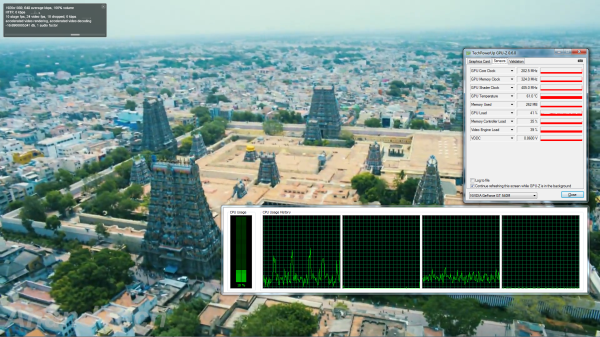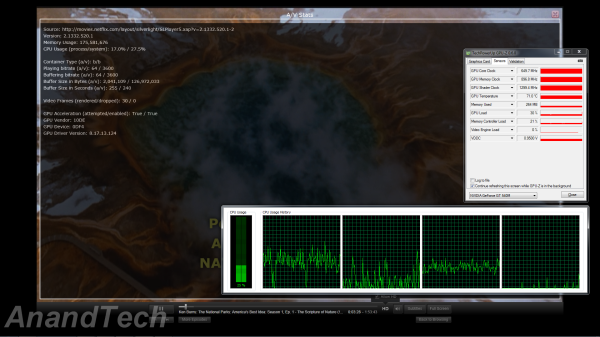ASRock's High-End Vision 3D 252B HTPC Review
by Ganesh T S on May 7, 2012 6:15 AM EST- Posted in
- Home Theater
- Sandy Bridge
- HTPC
- GT 540M
- NVIDIA
The ASRock Vision 3D 252B is covered quite nicely with respect to networking hardware. With support for both Gigabit Ethernet and 802.11n, it really doesn't matter if you keep the unit beyond cable reach from the router. All our network streaming tests were carried out with a 300 Mbps 802.11n network (currently provided in my lab location by a RT-N16 802.11n gigabit router from Asus). We were easily able to stream HD clips of more than 50 Mbps. HD YouTube videos and HD Netflix streaming had no issues.
While on the topic of network streaming, let us take a brief look at how the system performs while accessing online video services. We used Flash 11.2 in Firefox with NVIDIA's v301.24 drivers for testing. The first set of screenshots below show the CPU usage while playing back a 1080p YouTube video with hardware acceleration enabled. This is the same clip used in all the other SFF HTPC reviews.
1080p YouTube HD Streaming with Hardware Acceleration (Flash in Firefox)
Netflix streaming, on the other hand, uses Microsoft's Silverlight technology. Unlike Flash, hardware acceleration for the video decode process is not controlled by the user. It is upto the server side code to attempt GPU acceleration. Thankfully, Netflix does try to take advantage of the GPU's capabilities. This is evident from the A/V stats recorded while streaming a Netflix HD video at the maximum possible bitrate of 3.8 Mbps. While the video is definitely not 1080p, we observe that the CPU utilization of around 18% is lower than the CPU usage for a 1080p YouTube video.
Netflix HD Streaming with Hardware Acceleration
Users of media streamers streaming online videos often have to put up with messages of the sort 'This content is not available on TV connected devices' or need to queue up the videos on a PC before accessing them through their media streamer box. HTPC users don't need to worry about any such limitations. On a side note, it is disappointing to see Netflix restrict its 1080p / DD+ 5.1 offerings to the PS3 and Roku 2. It is the PC platform which launched the streaming business for Netflix. It would be good if they do not relegate HTPC users to being second string consumers as their popularity grows.












60 Comments
View All Comments
BPB - Monday, May 7, 2012 - link
I am planing on doing the same thing. Been trying it out with my notebook and like the way it's working with my HDHomerun Prime, so it looks like I'm losing a notebook but gaining an HTPC that's going to use little power and can be unplugged and still used as a laptop when needed. Now I have to get an good size external HDD and I am set. The nice thing is when the notebook is in use as a notebook I can use my desktop PC and Xbox combination to record/watch TV.IntoxicatedPuma - Tuesday, May 8, 2012 - link
Yeah you could easily by an Asus U36 series for around $600-$650 with similar performance. I don't know that I agree with the article about desktop CPU's being noisy and hot. For half the price of that machine, you could build an H61 machine with a 2100T, same hard drive, and equivalent video card that was about the same size and used about the same amount of power, and wouldn't run any hotter or be any noticeably louder.yottabit - Monday, May 7, 2012 - link
Regarding the line:"We are a little worried about the full loading power consumption being more than what the power supply is rated for"
I'm not sure this is true since you are comparing apples to oranges. Power supplies are typically rated for DC OUTPUT but you are comparing the rated DC output to the draw at the wall. Assuming the PSU is 80% efficient, then a 90W rating should equal approximately 90W/0.8= 112.5 W at the wall. Just a food for thought, I see this error commonly.
ganeshts - Monday, May 7, 2012 - link
Thanks for the pointer. The power consumption of > 109 W is still more than that of the first generation Vision 3D which was 82 W. This still makes us worried. I am trying to determine the power efficiency of the PSU (Delta Electronics ADP-90CD DB).Angengkiat - Monday, May 7, 2012 - link
Hi Ganesh,Any idea what software to use if we want to play 3D nicely on the machine, cos I am using TMT5 but it does not seem to be able to display the same 3D effects compared to a dedicated bluray player?
Thanks!
EK
ganeshts - Monday, May 7, 2012 - link
That is a bit surprising. TMT 5 has full 3D Blu-ray support. Maybe the 3D Blu-ray player is assuming some settings which have to be configured in TMT 5 (like the depth of view). Also, did you run the NVIDIA 3D display setup?MichaelD - Monday, May 7, 2012 - link
$1.2K. REALLY? That's just nuts. Nice piece of hardware, but not worth what they're asking for it. Plus at this pricepoint there had better be an SSD in there. At least a 64GB for the OS and programs. There's enough room in the chassis for a second 2.5" drive. They should've done a 2-drive, SSD/HD combo at this price.ganeshts - Monday, May 7, 2012 - link
Agreed :) I have recommended the same to ASRock.tctc - Monday, May 7, 2012 - link
Hi - couple of questions about the twin GPU configuration1. What determines which GPU is used by a particular application?
2. Can the iGPU be disabled so that only the NVIDIA 540 is used?
Regards,
tctc
ganeshts - Monday, May 7, 2012 - link
Yes, this is handled by Virtu. If you don't install Virtu, the 540M is the only one that is used. You need Virtu to choose applications for which the iGPU gets used (commonly MediaConverter / any app for which you want to use QuickSync)